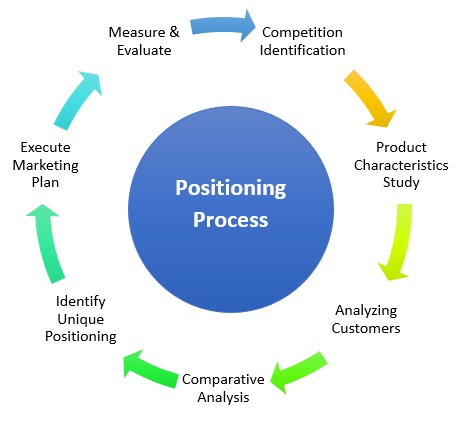- Business Concepts ›
- Marketing and Strategy ›
- Positioning Process
Positioning Process
Definition & Steps
This article covers meaning & overview of Positioning Process from marketing perspective.
What is meant by Positioning Process?
Positioning Process is the continuous & reiterative process which companies do to ensure strong, positive & stable positioning in a consumer’s mind. Positioning process enables companies to define the positioning of a brand, product or service.
Positioning Process Steps

Positioning of brand, products and services is a continuous game for companies. It is a reiterative process so that companies can continuous create a positive brand image in the mind of the customer based on their product offering. The final objective of a good positioning process strategy is to have a unique, distinct and strong positioning statement. The basic positioning process steps are as given below:
1. Competition Identification: The first step in the positioning process is understanding the competition and its products. Every company, brand, product or service has its unique position in the market. For creating a unique positioning, it is critical to understand the competition prevalent in the market in that particular sector. Perceptual mapping or brand mapping is often used for competitor positioning process.
2. Product Characteristics Identification: The second step in the positioning process is to evaluate all the qualitative characteristics, traits and uses of a product or service. The various characteristics of a product can be in terms of its usage, sturdiness, benefit, problem-solving, emotional connect etc.
3. Analyzing Customers: The third step in the positioning process is to understand the needs, psychology, personality etc of the customer. Unless a company understands a customer, it not create a proper positioning statement. Customer surveys, feedback forms etc can help understand the customer better.
4. Comparative Qualitative Analysis: The fourth step in the positioning process is to compare & analyses the data of competitors, qualitative customer inputs, external factors etc. On comparison, the gaps in the market can be understood.
5. Identify Unique Positioning: The fifth step in the positioning process is to identify a unique problem area or a gap which the product or service is fulfilling. This enables a company to have a strong and unique positioning vis-à-vis its competition.
6. Execute Marketing Plan: The sixth step in the positioning process is to create a strong marketing plan which would help in communicating the value proposition offered by the brand.
7. Measure & Evaluate: The last step in the positioning process is to measure, evaluate and constantly monitor the performance of the positioning of the brand in the mind of the customer. This is very important as a customer perception might completely differ from the message which the company is trying to portray. Sometimes, to rebrand or innovate or improve, companies do a repositioning of its products and services.
Hence, this concludes the definition of Positioning Process along with its overview.
This article has been researched & authored by the Business Concepts Team which comprises of MBA students, management professionals, and industry experts. It has been reviewed & published by the MBA Skool Team. The content on MBA Skool has been created for educational & academic purpose only.
Browse the definition and meaning of more similar terms. The Management Dictionary covers over 1800 business concepts from 5 categories.
Continue Reading:
What is MBA Skool?About Us
MBA Skool is a Knowledge Resource for Management Students, Aspirants & Professionals.
Business Courses
Quizzes & Skills
Quizzes test your expertise in business and Skill tests evaluate your management traits
Related Content
All Business Sections
Write for Us